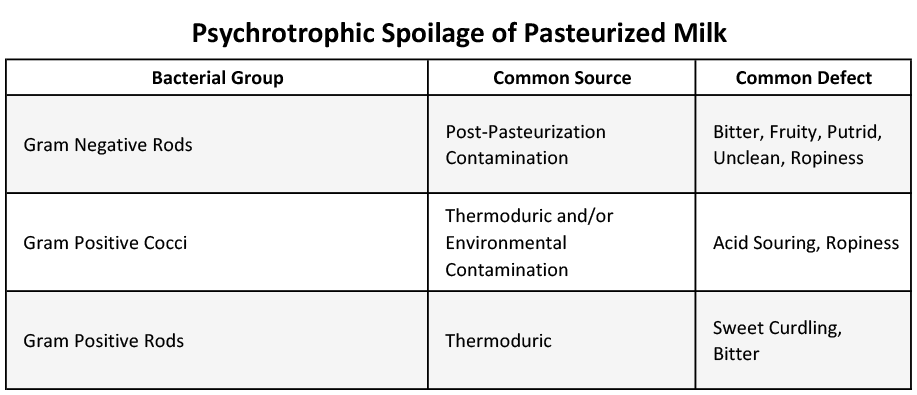Heat-Resistant Psychrotrophic Bacteria and Their Effect on the Quality of Pasteurized Milk
Heat-Resistant Psychrotrophic Bacteria or Heat-Resistant Psychrotrophs (HRP) can affect the quality of pasteurized milk. Have you ever poured milk from a carton only to see it come out in chunks? Have you ever gulped milk only to realize too late that it tastes awful?
Milk curdling and off-flavors in pasteurized fluid milk are huge turnoffs and could undoubtedly convince a consumer to change brands or switch to a different beverage completely.
Over the years, the collective efforts of the dairy industry and the increased regulatory involvement, have resulted in more effective control of post pasteurization contamination (PPC). As a result, the quality and safety of milk have improved greatly. The shelf life has increased from 10 – 14 days to 18 – 21 days. However, HRP bacteria are the barrier to improving shelf life beyond 18 – 21 days.
Monitoring and controlling milk spoilage from heat-resistant psychrotrophic bacteria
The likely culprits of milk spoilage are heat-resistant psychrotrophs, gram-positive bacteria that are present in the environment. They adapt well to cold environments like raw milk handling equipment, where they can establish a foothold by forming biofilms. The biofilms reduce the effectiveness of sanitizers to kill the bacteria. Their presence in pasteurized milk results from inefficiency in the sanitation of raw milk equipment. (See research article, Heat Resistant Psychrotrophic Bacteria in Raw Milk and Their Growth at 7 C., M. MIKOLAJCIK, N. T. SIMON; J Food Prot 1 February 1978; 41 (2): 93–95. doi: https://doi.org/10.4315/0362-028X-41.2.93).

Heat-resistant psychrotrophic bacteria are unique because they can survive pasteurization and can grow at refrigeration temperatures. The cold environment of raw milk handling equipment favors psychrotrophic bacteria growth.
Their ability to survive pasteurization is primarily due to their spore-forming capabilities. Spores are a mechanism to help bacteria survive stressful environmental conditions. When these spore-forming bacteria are stressed during the washing, sanitizing, or drying of milk equipment, they can sporulate.
They will remain dormant until being shocked into outgrowth by the pasteurization process. This eventually results in product defects, such as curdling and off-flavors. Unfortunately, there is no quick way to detect these bacteria in either raw or pasteurized milk, as time is needed for incubation. However, contamination rates as low as a single heat-resistant psychrotrophic bacterium per liter can cause quality defects in pasteurized milk.
Industry best practices for verification and identifying the source of psychrotrophic bacteria
Reducing the effect of psychrotrophic bacteria requires vigilance in cleaning and sanitizing all milk processing equipment. This includes farm bulk tanks, trucks, and raw silos. If there are indicators of quality defects, the following methods can verify the presence of heat-resistant psychrotrophic bacteria and determine the source of contamination.
This best practice procedure can verify whether heat-resistant psychrotrophic bacteria are causing quality defects in pasteurized milk.
- Aseptically obtain a two or five-liter milk sample from the pasteurizer. Incubate the bagged sample at 45 degrees F. (7 degrees C.) for 18 to 24 days.
- The incubated sample will be representative of the bacteria in the milk that can cause spoilage.
- Conduct a standard plate count and gram stain any samples with counts greater than 1,000,000/milliliters.
- If the results of the gram stain indicate gram-positive bacteria, they are very likely heat-resistant psychrotrophs.
The next step is to trace the bacteria back to your raw milk handling equipment. The most likely source of the bacteria is raw silos due to ineffective cleaning and sanitizing, but silos may not be the only source. Potential sources can also include farm bulk tanks and trucks.
To help identify the bacterial source:
- First, aseptically fill a sterile 250 ml bag with raw milk.
- Second, lab pasteurize (LP) the sample at 167 degrees F. (75 degrees C.) for 20 minutes.
- Then, place the sample in a 45 degrees F. (7 degrees C.) keeping quality incubator, and hold for 18 days or to end of code.
- The incubated sample is representative of the bacteria in the milk that causes the quality defects. The final step is identifying any bacteria by plate counts and gram staining.
Remember, the presence of heat-resistant psychrotrophic bacteria in pasteurized milk results from inefficiency in the sanitation of raw milk equipment. Contamination rates as low as a single psychrotrophic bacterium per liter can cause quality defects in pasteurized milk.
Aseptic and representative sampling applications can help identify the presence of heat-resistant psychrotrophic bacteria in pasteurized milk and then determine the source of contamination.
Have questions about aseptic and representative sampling? Ask Our Experts




